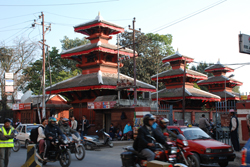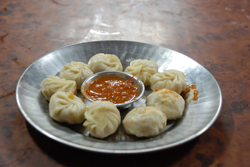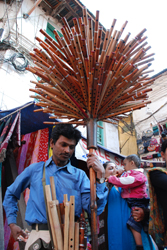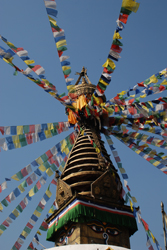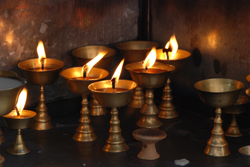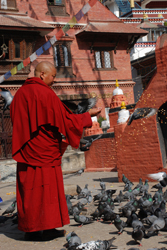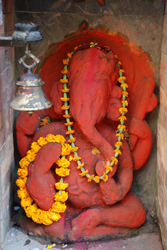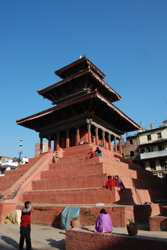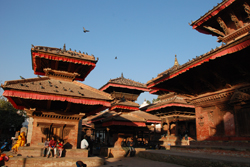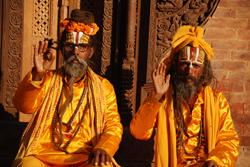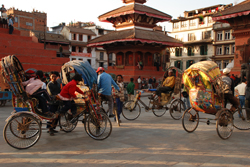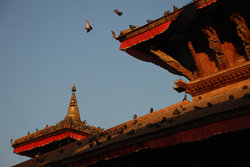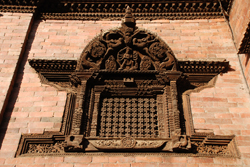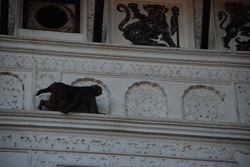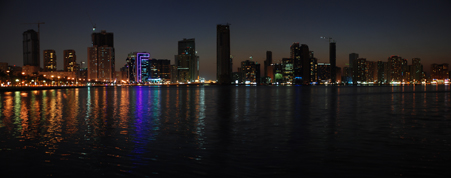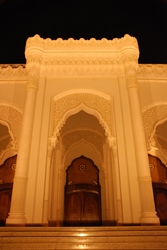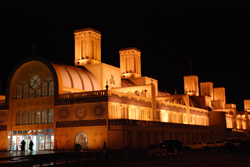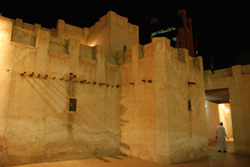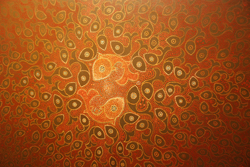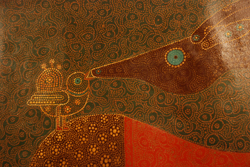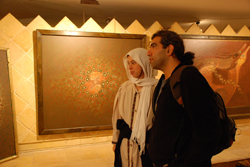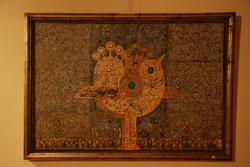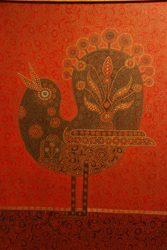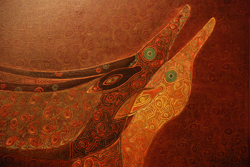Kathmandu: A Feast for the Senses
27 November, 2008, 02:31 am in "Nepal"
Even after a night of no sleep and 2 flights, I couldn't help being excited as we approached Kathmandu. What I thought at first were cloud banks were rows of the snow-capped Himalayan mountains, glistening white. The plane flew parallel to the peaks for an impressive amount of time.
Once landed, we took a taxi to Thamel. It is the tourist ghetto, but with no sleep we wanted to find a hotel as quickly and easily as possible and Thamel is the place for that.
I couldn't help smiling as we progressed through the crazy crowded streets. We passed the Hindu temple of Pashupatinath and lots of people dressed in bright colors. In the distance, green hills rose through the haze.
Thamel feels a bit more like old Berkeley or Haight Ashbury than Nepal with cafes, restaurants, bars blasting rock music and stores of outdoor clothing (almost all knock offs) as well as stores of hand woven clothing that you see more on neo-hippies (or me) than Nepalese. What makes it different from the Bay Area are the number of motorbikes and bicycle rickshaws as well as the Nepalese people, the Tiger Balm and mini chessboard salespeople, and the pollution.
We found an awesome little hole-in the wall restaurant where we had a tasty meal of momos (won tons/raviolis/pelmeni) with vegetable and potato fillings. After wandering a little in the Thamel area, we headed back to the hotel to finally get a good night's sleep.
We found an awesome little hole-in the wall restaurant where we had a tasty meal of momos (won tons/raviolis/pelmeni) with vegetable and potato fillings. After wandering a little in the Thamel area, we headed back to the hotel to finally get a good night's sleep.
The main sight in Kathmandu is Durbar Square. We decided to walk there from Thamel. Once out of Thamel, the streets were still busy but the businesses were geared towards locals. Every block seemed to yield a surprise: a building with beautiful wood carvings, women selling garlands of marigolds on the steps of a shrine, flute sellers with bundles of flutes rising above their heads like palm tree branches.
We almost walked right past a narrow alley leading to a splendid white stupa rising from the middle of a square, its garlands of prayer flags almost transparent from weathering. The eyes of Buddha were painted on it, watching over flocks of pigeons being fed by monks in red robes. It was called the Kathesimbhu Stupa.
On one side of the square, a Buddha statue sat inside a shrine. Back on the main street, we passed shrines to Ganesh covered in red pigment as well as shrines to other Hindu gods.
We took a wrong road and ended up by a huge white tower. Eventually we got directions and turned back to the right road. We came to an impressive Hindu shrine with carved roof supports and a statue of a bull at the foot. The temple was the Jaisi Deval temple devoted to Shiva and the bull was Nandi who is Shiva's primary form of transportation. People sat talking on the steps and around the upper level there were men sleeping in the sun. In the chaotic streets, the multi-stepped temples seem to lift people out of the noise and dirt into the fresher air and within reach of the sun.
A little North of the shrine we came to Durbar square and really couldn't imagine how we missed it. The square (or squares) is huge and filled with Hindu temples, shrines, and a palace or two. It is hard to decide where to look first. The red painted steps rose to multi-tiered roofs of brown wood with ornate carved supports showing gods and consorts, animals and symbols. The roof eves are adorned with red ruffled cloth which ripple in the wind. Some eves are adorned with chimes. The square is filled with locals passing through, tourists staring with wonder, salespeople, ornately dressed sadhus with painted faces and long dreds.
We walked into one ornate building, which turned out to be the home of Kumari, the Living Goddess, a girl who is considered to be the living incarnation of the Goddess Durga. The girl is chosen when she is 3 or 4 after undergoing various tests. She then is confined to the house except during a couple festivals a year, until she reaches puberty and becomes a mortal again.
We continued wandering around the various temples. Then I noticed 2 monkeys running along the wall of a white palace. This turned out to be (appropriately) the Hanuman (monkey god) palace. In front was a small Hanuman statue completely covered with fabric drapes.
One shock for me is the contrast between the imagery of Islamic Iran and Central Asia--repeated patterns, flowers, designs, calligraphy, and almost no figurative representations--to the Hindu imagery with so many physical representations of gods, animals, as well as strange creatures and incarnations of gods with fearsome faces, skulls, and swords, as well as very graphic erotic carvings. It captures the senses: the sounds of the bells, the smell of incense, the visual stimuli, the warmth and scent of candles. The shrines seem dark and mysterious inside. The images are mysterious, frightening and beautiful. Standing on the steps of one of the shrines looking at the other temples and shrines, I was impressed by the beauty and strangeness. Below, the gold clad sadhus left their seat at a picturesque shrine and headed home for the day.
Sharjah:15 hours in the Cultural Capitol of the Arab World
24 November, 2008, 03:27 am in "UAE"
I had never heard of Sharjah until, while searching for a cheap flight to India, I came across it as a layover point between Tehran and Delhi. Hmm... Sharjah... Where's that? I assumed it must be in Saudi Arabia because the stop over was on Air Arabia. I didn't look into it further until, after realizing we couldn't get Indian visas in Iran, we were looking for other route alternatives. The cheapest, most logical option was Kathmandu via Sharjah. Sharjah is not in Saudi Arabia but in the United Arab Emirates. It is described as a sleeper community where people who work in Dubai live because it is cheaper than living in Dubai. This evoked exciting images in my mind of.... Fresno! Or.... Riverside! Doing a bit more research, I found the Sharjah Tourism website which describes Sharjah as the “cultural capitol of the Arab World.” The website listed the historic Heritage District, an arts district and so many museums I wasn't able to check them all before I lost our Internet connection.
A brand new art museum had recently opened. Add to this a location on the Arab Gulf, Sharjah didn't sound too shabby. At least, I figured, we could find something to do for our 15 hour layover.
Rowshan's parents drove us to the airport this morning. Somewhere, not anywhere near the airport, Rowshan's dad's car broke down. He said it was a fuse and sent Rowshan digging through the glove compartment for an extra he had. Once Rowshan found it, he, his mom, and I grabbed a taxi and left his dad to fix the car. At the airport we checked in then went back out through security to say “bye” to Rowshan's mother and father (who had fixed the car and was pulling into the airport).
We went back through the security. I had to go through the women's side. Meanwhile the male security guy informed Rowshan he was, “dressed suspiciously.” For future reference to anyone traveling in Iran, “suspicious dress” is neutral colored travel plants (the kind that dry quickly and the legs can be zipped off into shorts), a black Thai cotton long sleeved shirt with ornamental neck embroidery, and hiking shoes. One has to feel sorry for Rowshan. In the US the airport security finds him suspicious because he is Iranian. In Iran the airport security finds him suspicious because he wears travel clothing. The security guy let him through anyway. We managed to leave Iran without any further problems and soon we had crossed the Arab Gulf and were descending over rippled beige sands dotted with scraggy plants, and landed in the Sharjah airport.
Upon leaving the airport, I was struck by a wave of balmy heat (the temperature was 29 degrees C)as well as a faint scent of the sea which managed to drift above the smell of the car exhaust.
The bus to the center (#14) had only one other person on it. The driver signaled to me to sit in one of the front seats marked “Ladies only”. He wouldn't let Rowshan sit next to me so Rowshan sat in one of the seats behind. The bus left the airport and headed down a straight road over flat desert which seemed to be quickly being developed and covered with newly constructed houses and palm trees. Above the flat flat landscape, white and cream minarets rose in slender pinnacles which caught the light of the golden sun.
We were moving along at a good pace through empty streets when all of a sudden the bus came to a halt. Ahead of us was a big line of trucks. In the distance we could see the skyscrapers of downtown. It took an hour to go the couple kilometers to the downtown. A little farther down the street, the bus stopped at a legitimate bus stop. Within a few minutes it was full of young men who were definitely not Arab. They were probably workers from Nepal or India. The driver herded them on making sure each paid and a few times rather rudely threw one or two off. Rowshan, seeing the crowd of men boarding, jumped into the seat next to me. The driver approved and let him stay though later when one other woman boarded, Rowshan stood up and let her sit.
Dismayed, we saw the sun set, a glowing ball behind industrial buildings. By the time we got off the bus it was dark. We walked towards the lagoon past restaurants and cafeterias. However, instead of shwarma, the smells of Indian curry drifted from them. Along the Khaled lagoon was a paved path following the shore with benches. Next to the path was a manicured lawn dotted with palm trees.
Across the water was a skyline reminiscent of cities in the US. In fact, with the skyline across the water, the smell of ocean, the palm trees and the balmy air, it made me think of San Diego. Across from the park there was even several US fast food joints: KFC, Pizza Hut, and Burger King (McDonalds was on the next street over.) After 3 weeks in Iran and 3 months in Central Asia, it was an odd feeling being in some place so modern and heavily influenced by the US. In the park, people jogged, couples strolled and families had picnics on the grass. We ate our lunch which Rowshan's mom had provided, then walked up the path admiring the Al Noor mosque and the Central Souq. Both were lit so they seemed like they were carved from alabaster. The Souq was decorated with rows of fake wind towers. The tourist info brochure says it was the first souq with air conditioning (assuming of the electronic variety) which made the fake wind towers kind of ironic.
From the park the city seemed very rich, modern and elegant. However, I was eager to leave in search of the Heritage District. The historic area, we walked away from the water and soon were in a busy, though perhaps slightly seedy area of stores, “cheap” hotels, lots of men and very few women. The signs were in Arabic and English but the dominant smell was still curry and most of the restaurants served Indian food. The Heritage district isn't obvious because its buildings are hidden behind the new skyscrapers. I saw the space behind the skyscrapers (ie. an area lacking skyscrapers) before I saw the low stone/coral buildings.
It was getting late so most of the buildings were closed, however we were able to wander around. The area was peaceful and quiet. The buildings were let by small lanterns along the walls. Some were on open squares. Others were right next to each other with narrow mysterious looking paths between.
The buildings were calm and simple with pretty wind towers rising above them from the inside. The walls were smooth covered with either plaster or adobe. Though some walls showed stone or coral (as I think I've read). People were mostly just using the area to cut through to the other side but in some places groups of men sat on the ground talking.
It was getting late so most of the buildings were closed, however we were able to wander around. The area was peaceful and quiet. The buildings were let by small lanterns along the walls. Some were on open squares. Others were right next to each other with narrow mysterious looking paths between.
The buildings were calm and simple with pretty wind towers rising above them from the inside. The walls were smooth covered with either plaster or adobe. Though some walls showed stone or coral (as I think I've read). People were mostly just using the area to cut through to the other side but in some places groups of men sat on the ground talking.
Though I would have liked to eat a meal of Gulf food, most of the food options seemed to be Indian or US fast food. Finally we found a chicken shwarma place and we got a chicken sandwich and stuffed grape leaves. By the time we finished it was midnight. We thought there was a bus to the airport at 1 but it turned out R and the bus driver misunderstood each other. R was piecing together Arabic words to ask what time the last bus was creating a phrase “time bus night”. The driver answered “one”. Later we decided the driver had interpreted it as asking how long the bus trip was and answered “one” meaning “one hour” not “one o'clock” as we had believed. We easily caught a taxi to the airport.
After more espresso (we had coffee drinks earlier as well), we killed time waiting for our flight to board (check-in at 4:15AM, boarding 6:45). The waiting area beyond passport control is a makeshift dormitory with people sleeping on chairs stretched out with blankets on the floor. We found a couple seats in the less crowded area and settled down to watch the time go by.
After more espresso (we had coffee drinks earlier as well), we killed time waiting for our flight to board (check-in at 4:15AM, boarding 6:45). The waiting area beyond passport control is a makeshift dormitory with people sleeping on chairs stretched out with blankets on the floor. We found a couple seats in the less crowded area and settled down to watch the time go by.
Painting Exhibition by Mohammad Hadi Fadavi at Pasargadae Gallery
21 November, 2008, 03:27 am in "Iran"
Mitra invited us to an art opening of a friend's exhibition. The gallery was in the North in one of the wealthier parts of town. It was a nice space in the downstairs of a house which had been tiled and had raised platforms around the edges for exhibitions. The paintings were mostly canvases hanging from leather and wood bars decorated with carvings of some of the subjects of the paintings. The paintings themselves were figures made up of repeated shapes-- mostly fish-- which were themselves made up of dots.
The colors were warm and deep subtle reds, yellows, browns, and turquoises which were used to create spots of lights. The subjects were deer, fish, and birds from folkloric motives. There were also plant and flower motives merging with the animals. The over all result was one of peaceful beauty and unity of subjects and individual parts that made them up.
Later we talked with the artist, Mohammad Hadi Fadavi. He said the deer, birds, and fish were from Persian ceramics. He used fish frequently because they were a symbol of peace and love. He also said they were a symbol of plenty-- from the bible story of fishes and loaves. This was suitable because a percentage of the price went to benefit the UN World Food Program.
The birds when together had beaks closed as a symbol of peace but when they were apart, had beaks open screaming for unity. He pointed out the pairs of deer were painted so neither dominated the other but rather they merged as equal, united. He explained all his paintings were about love and unity. One fish painting merged into a shape of a whirling dervish. He also pointed out the flower motive he used as being a lotus because of the significance in Persian and Indian art as well as Buddhism. There was also a tree which he used Sarv (Cedar) because Persian poets often referred to it.
[ View 2 Comments
|
]
Powered by My Blog 1.69. Copyright 2003-2006 FuzzyMonkey.net.
Created by the scripting wizards at FuzzyMonkey.net..
(Code modified by Rowshan Dowlatabadi)
Created by the scripting wizards at FuzzyMonkey.net..
(Code modified by Rowshan Dowlatabadi)



